Accelerometer ADXL335 Interfacing with AVR ATmega16
Introduction
Accelerometer is an electromechanical device that measures force of acceleration due to gravity in g unit.
It can be used for tilt sensing applications (Example: In mobile phones, gaming applications etc).
The ADXL335 measures acceleration along X, Y and Z axes.
It gives analog voltage output proportional to the acceleration along the 3 axes.
These voltages can be converted to digital signal using ADC and then processed by microcontroller to find out the tilt.
For more information about ADXL335 accelerometer and how to use it, refer the topic ADXL335 Accelerometer Module in the sensors and modules section.
For information about ADC in ATmega16 and how to use it, refer the topic ADC in AVR ATmega16/ATmega32 in the ATmega inside section.
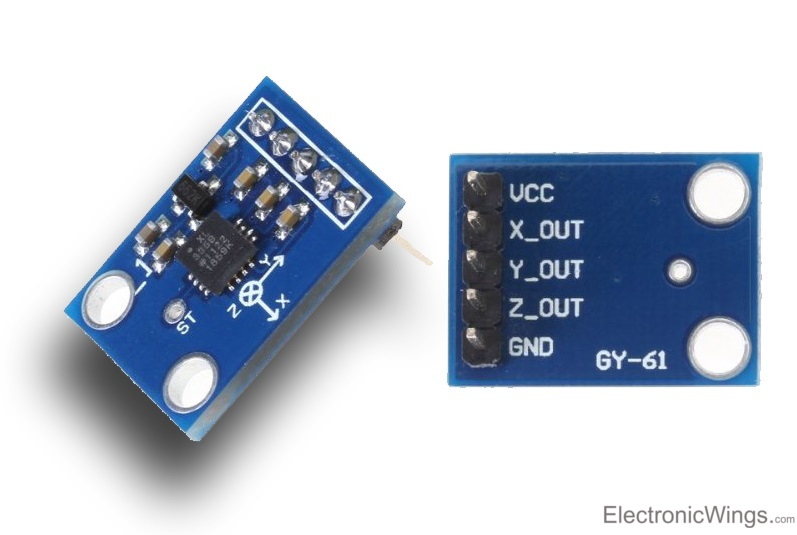
ADXL335 Accelerometer Module
Interfacing Accelerometer ADXL335 with AVR ATmega16
- As module has analog output. we will measure it using ADC channels of ATmega16.
- ATmega16 has ADC pins on its PORT A and it has 8 input channels.
- So we will connect X, Y and Z analog output of ADXL335 module to three input ADC channels of ATmega16, say channel0, channel1, channel2 respectively.
- And after reading ADC values of X, Y and Z from the module, we will send it to the PC/Laptop over USART.
Interfacing diagram
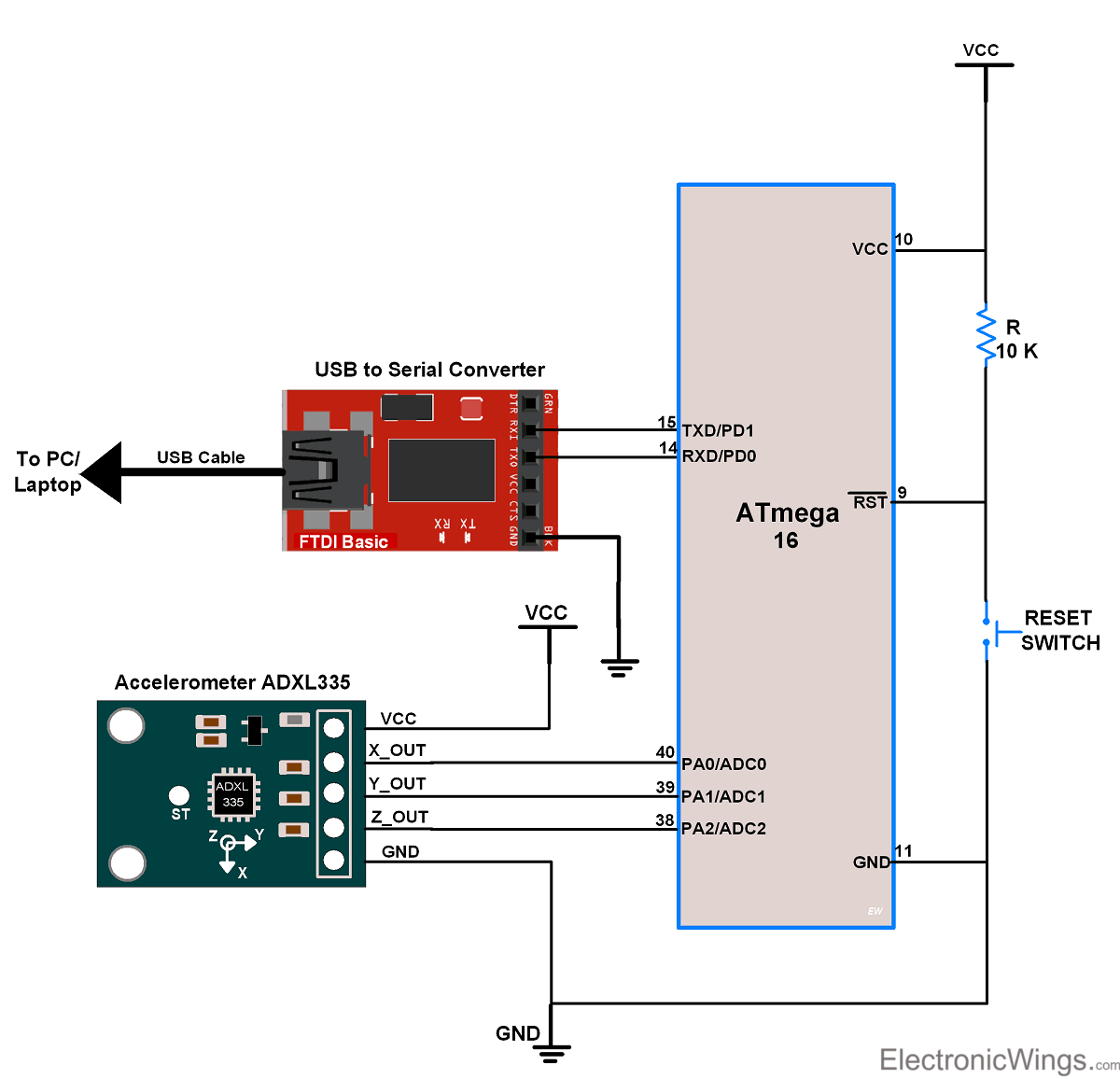
Interfacing ADXL335 Accelerometer Module With ATmega 16
Program 1
/*
* ATmega16_Accelerometer.c
* http://www.electronicwings.com
*
*/
#define F_CPU 8000000UL /* Define CPU clock Frequency 8MHz */
#include <avr/io.h> /* Include AVR std. library file */
#include <util/delay.h> /* Include defined delay header file */
#include <stdio.h> /* Include standard i/o library file */
#include "USART_RS232_H_file.h" /* Include USART header file */
void ADC_Init() /* ADC Initialization function */
{
DDRA = 0x00; /* Make ADC port as input */
ADCSRA = 0x87; /* Enable ADC, with freq/128 */
ADMUX = 0x40; /* Vref: Avcc, ADC channel: 0 */
}
int ADC_Read(char channel) /* ADC Read function */
{
ADMUX = 0x40 | (channel & 0x07);/* set input channel to read */
ADCSRA |= (1<<ADSC); /* Start ADC conversion */
while (!(ADCSRA & (1<<ADIF))); /* Wait until end of conversion by polling ADC interrupt flag */
ADCSRA |= (1<<ADIF); /* Clear interrupt flag */
_delay_ms(1); /* Wait a little bit */
return ADCW; /* Return ADC word */
}
int main(void)
{
char buffer[50];
int ADC_X_VALUE,ADC_Y_VALUE,ADC_Z_VALUE;
USART_Init(9600); /* Initialize USART with 9600 Baud rate */
ADC_Init(); /* Initialize ADC */
while(1)
{
ADC_X_VALUE = ADC_Read(0); /* Read X, Y, Z axis ADC value */
ADC_Y_VALUE = ADC_Read(1);
ADC_Z_VALUE = ADC_Read(2);
sprintf(buffer,"X = %d\t Y = %d\t Z = %d\n\r",ADC_X_VALUE,ADC_Y_VALUE,ADC_Z_VALUE);
USART_SendString(buffer); /* Send X, Y, Z value Serially */
_delay_ms(30);
}
}
Output Window
On PC/Laptop’s serial terminal application, we can see directly X, Y, Z’s ADC values as shown in below figure. For testing tilt the module in X and Y direction and observe the changes in X and Y values.
- If we tilt module on X-axis, we get variations in X and Z values whereas Y will remain nearly constant.
- If we tilt module on Y-axis, we get variations in Y and Z values whereas Y will remain nearly constant.
Output window of ADC values.
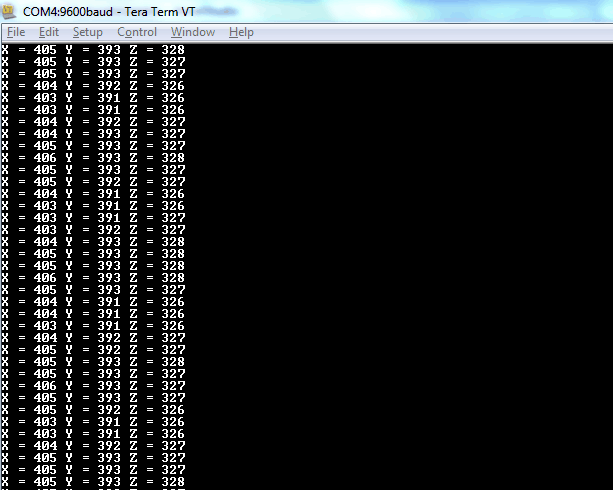
Now let’s see how to calculate angle of tilt or inclination,
Program 2
/*
* ATmega16_Accelerometer.c
* http://www.electronicwings.com
*
*/
#define F_CPU 8000000UL /* Define CPU clock Frequency e.g. here its 8MHz */
#include <avr/io.h> /* Include AVR std. library file */
#include <util/delay.h> /* Include defined delay header file */
#include <stdlib.h> /* Include standard library file */
#include <math.h> /* Include math header file */
#include "USART_RS232_H_file.h" /* Include USART header file */
void ADC_Init() /* ADC InitialiAzouttion function */
{
DDRA = 0x00; /* Make ADC port as input */
ADCSRA = 0x87; /* Enable ADC, with freq/128 */
ADMUX = 0x40; /* Vref: Avcc, ADC channel: 0 */
}
int ADC_Read(char channel) /* ADC Read function */
{
ADMUX = 0x40 | (channel & 0x07);/* set input channel to read */
ADCSRA |= (1<<ADSC); /* Start ADC conversion */
while (!(ADCSRA & (1<<ADIF))); /* Wait until end of conversion by polling ADC interrupt flag */
ADCSRA |= (1<<ADIF); /* Clear interrupt flag */
_delay_ms(1); /* Wait a little bit */
return ADCW; /* Return ADC word */
}
void SendSerial(char* str, double value, char unit)
{
char buffer[10];
dtostrf(value,4,2,buffer);
USART_SendString(str); /* Send Name string */
USART_SendString(buffer); /* Send value */
USART_TxChar(unit); /* Send unit char */
USART_TxChar('\t'); /* Send tab char */
_delay_ms(10);
}
int main(void)
{
int ADC_X_VALUE,ADC_Y_VALUE,ADC_Z_VALUE;
double Axout,Ayout,Azout,theta, psy, phi,roll,pitch,yaw;
USART_Init(9600); /* Initialize USART with 9600 Baud rate */
ADC_Init(); /* Initialize ADC */
while(1)
{
ADC_X_VALUE = ADC_Read(0); /* Read X, Y, Z axis ADC value */
ADC_Y_VALUE = ADC_Read(1);
ADC_Z_VALUE = ADC_Read(2);
/* Convert values in g unit */
Axout = (((double)(ADC_X_VALUE*5)/1.024)-1700.0)/330.0;
Ayout = (((double)(ADC_Y_VALUE*5)/1.024)-1700.0)/330.0;
Azout = (((double)(ADC_Z_VALUE*5)/1.024)-1700.0)/330.0;
/* Calculate angles */
theta = atan(Axout/(sqrt((pow (Ayout,2.0))+(pow (Azout,2.0)))))*57.29577951;
psy = atan(Ayout/(sqrt((pow (Axout,2.0))+(pow (Azout,2.0)))))*57.29577951;
phi = atan((sqrt((pow (Ayout,2.0))+(pow (Axout,2.0))))/Azout)*57.29577951;
roll = (atan2(Ayout,Azout))*57.29577951+180;
pitch = (atan2(Azout,Axout))*57.29577951+180;
yaw = (atan2(Axout,Ayout))*57.29577951+180;
SendSerial("Axout = ",Axout,'g');/* Send All value */
SendSerial("Ayout = ",Ayout,'g');
SendSerial("Azout = ",Azout,'g');
SendSerial("Theta = ",theta,248);
SendSerial("Psy = ",psy,248);
SendSerial("Phi = ",phi,248);
SendSerial("Roll = ",roll,248);
SendSerial("Pitch = ",pitch,248);
SendSerial("Yaw = ",yaw,248);
USART_SendString("\n\r");
}
}
Output Window
- Acceleration in g unit:
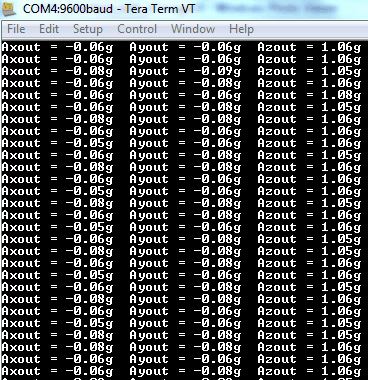
2. Angle of Inclination
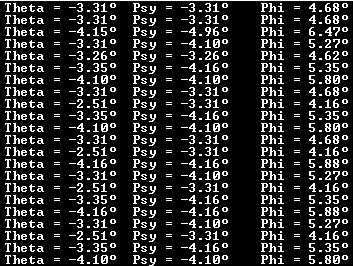
3. Angle of Rotation
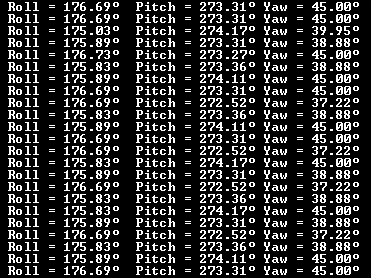

No comments:
Post a Comment